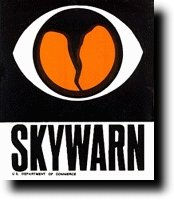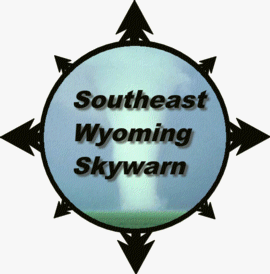|
How To Become a Skywarn Spotter |
|---|
If you are interested in becoming a Trained Skywarn Spotter ask your local Skywarn Chapter, Amateur Radio Group, or local National Weather Service Office, on how to become a member. Some organizations may require an Amateur Radio License to join thier local chapter. Please keep in mind that Weather Spotting can be a dangerous activity. Weather Spotting is not 'chasing'.
|
Severe Weather Reporting Criteria |
|---|
 Tornadoes, Debris Clouds, or Funnels Aloft. Tornadoes, Debris Clouds, or Funnels Aloft.
 Wall Clouds (Especially if Rotation is
Present). Wall Clouds (Especially if Rotation is
Present).
 Hail 1 Inch or Larger. Hail 1 Inch or Larger.
 Winds Greater than 58 MPH. Winds Greater than 58 MPH.
 Rain Fall Greater than 1 Inch Per Hour
Measured. Rain Fall Greater than 1 Inch Per Hour
Measured.
 Flooding Which Poses a Hazard. Flooding Which Poses a Hazard.
 Wind or Other Storm Damage to Buildings,
Crops, etc. Wind or Other Storm Damage to Buildings,
Crops, etc.
 Hail Accumulations Which pose a Hazard
or cause flooding. Hail Accumulations Which pose a Hazard
or cause flooding.
| Hail
Diameter
| Size
Description
|
| 1/4" |
Pea
Size |
| 1/2" |
Marble
Size |
| 3/4" (Old
Severe Criteria) |
Dime
Size |
| 7/8" |
Nickel
Size |
| 1" (New Severe Criteria) |
Quarter
Size |
| 1
1/4" |
Half
Dollar Size |
| 1
1/2" |
Walnut
or Ping Pong Ball Size |
| 1
3/4" |
Golf
Ball Size |
| 2" |
Hen
Egg Size |
| 2
1/2" |
Tennis
Ball Size |
| 2
3/4" |
Baseball
Size |
| 3" |
Teacup
Size |
| 4" |
Softball
Size |
| 4
1/2" |
Grapefruit
Size |
|
Wind Speed Estimates and Descriptors |
|---|
| Wind
Speed Estimate
| Description
|
| 25-31
mph |
Large
branches in motion;
whistling heard in telephone wires |
| 32-38
mph |
Whole
trees in motion;
inconvenience felt walking against the wind |
| 39-54
mph |
Twigs
break off trees;
wind generally impedes progress |
| 55-72
mph |
Damage
to chimneys and TV antennas;
pushes over shallow rooted trees |
| 73-112
mph |
Peels
surfaces off roofs; windows broken; light mobile homes
pushed or overturned;
moving cars pushed off road |
| 113-157
mph |
Roofs
torn off houses;
cars lifted off ground |
|
The Enhanced Fujita Scale |
|---|
| FUJITA SCALE |
DERIVED EF SCALE |
OPERATIONAL EF SCALE |
| F Number |
Fastest 1/4-mile (mph) |
3 Second Gust (mph) |
EF Number |
3 Second Gust (mph) |
EF Number |
3 Second Gust (mph) |
| 0 |
40-72 |
45-78 |
0 |
65-85 |
0 |
65-85 |
| 1 |
73-112 |
79-117 |
1 |
86-109 |
1 |
86-110 |
| 2 |
113-157 |
118-161 |
2 |
110-137 |
2 |
111-135 |
| 3 |
158-207 |
162-209 |
3 |
138-167 |
3 |
136-165 |
| 4 |
208-260 |
210-261 |
4 |
168-199 |
4 |
166-200 |
| 5 |
261-318 |
262-317 |
5 |
200-234 |
5 |
Over 200 |
| F-Scale Number
| Intensity Phrase
| Wind Speed
| Type of Damage Done
|
| F0 |
Gale tornado |
40-72 mph |
Some damage to chimneys;
breaks branches off trees; pushes over shallow-rooted
trees; damages sign boards. |
| F1 |
Moderate tornado |
73-112 mph |
The lower limit is the
beginning of hurricane wind speed; peels surface off
roofs; mobile homes pushed off foundations or
overturned; moving autos pushed off the roads; attached
garages may be destroyed. |
| F2 |
Significant tornado |
113-157 mph |
Considerable damage. Roofs
torn off frame houses; mobile homes demolished; boxcars
pushed over; large trees snapped or uprooted; light
object missiles generated. |
| F3 |
Severe tornado |
158-206 mph |
Roof and some walls torn
off well constructed houses; trains overturned; most
trees in forest uprooted |
| F4 |
Devastating tornado |
207-260 mph> |
Well-constructed houses
leveled; structures with weak foundations blown off some
distance; cars thrown and large missiles generated. |
| F5 |
Incredible tornado |
261-318 mph |
Strong frame houses lifted
off foundations and carried considerable distances to
disintegrate; automobile sized missiles fly through the
air in excess of 100 meters; trees debarked; steel re-inforced
concrete structures badly damaged. |
| F6 |
Inconceivable tornado |
319-379 mph |
These winds are very
unlikely. The small area of damage they might produce
would probably not be recognizable along with the mess
produced by F4 and F5 wind that would surround the F6
winds. Missiles, such as cars and refrigerators would do
serious secondary damage that could not be directly
identified as F6 damage. If this level is ever achieved,
evidence for it might only be found in some manner of
ground swirl pattern, for it may never be identifiable
through engineering studies |
NOTE: The Fujita Scale is based on damage, not
the appearance of the funnel.
|
Spotter Guides and Weather Glossaries |
|---|
NOAA
Basic Spotters Field Guide
NOAA
Advanced Spotters Field Guide
NOAA Comprehensive Glossary Of Weather Terms For Storm Spotters.
NOAA Glossary
of Weather Terms, Abbreviations, and Acronyms
|
 Tornadoes, Debris Clouds, or Funnels Aloft.
Tornadoes, Debris Clouds, or Funnels Aloft.
 Wall Clouds (Especially if Rotation is
Present).
Wall Clouds (Especially if Rotation is
Present). Hail 1 Inch or Larger.
Hail 1 Inch or Larger. Winds Greater than 58 MPH.
Winds Greater than 58 MPH. Rain Fall Greater than 1 Inch Per Hour
Measured.
Rain Fall Greater than 1 Inch Per Hour
Measured.  Flooding Which Poses a Hazard.
Flooding Which Poses a Hazard. Wind or Other Storm Damage to Buildings,
Crops, etc.
Wind or Other Storm Damage to Buildings,
Crops, etc.  Hail Accumulations Which pose a Hazard
or cause flooding.
Hail Accumulations Which pose a Hazard
or cause flooding.
 Copyright © 1994-2024, Southeast Wyoming Skywarn.
Copyright © 1994-2024, Southeast Wyoming Skywarn.
